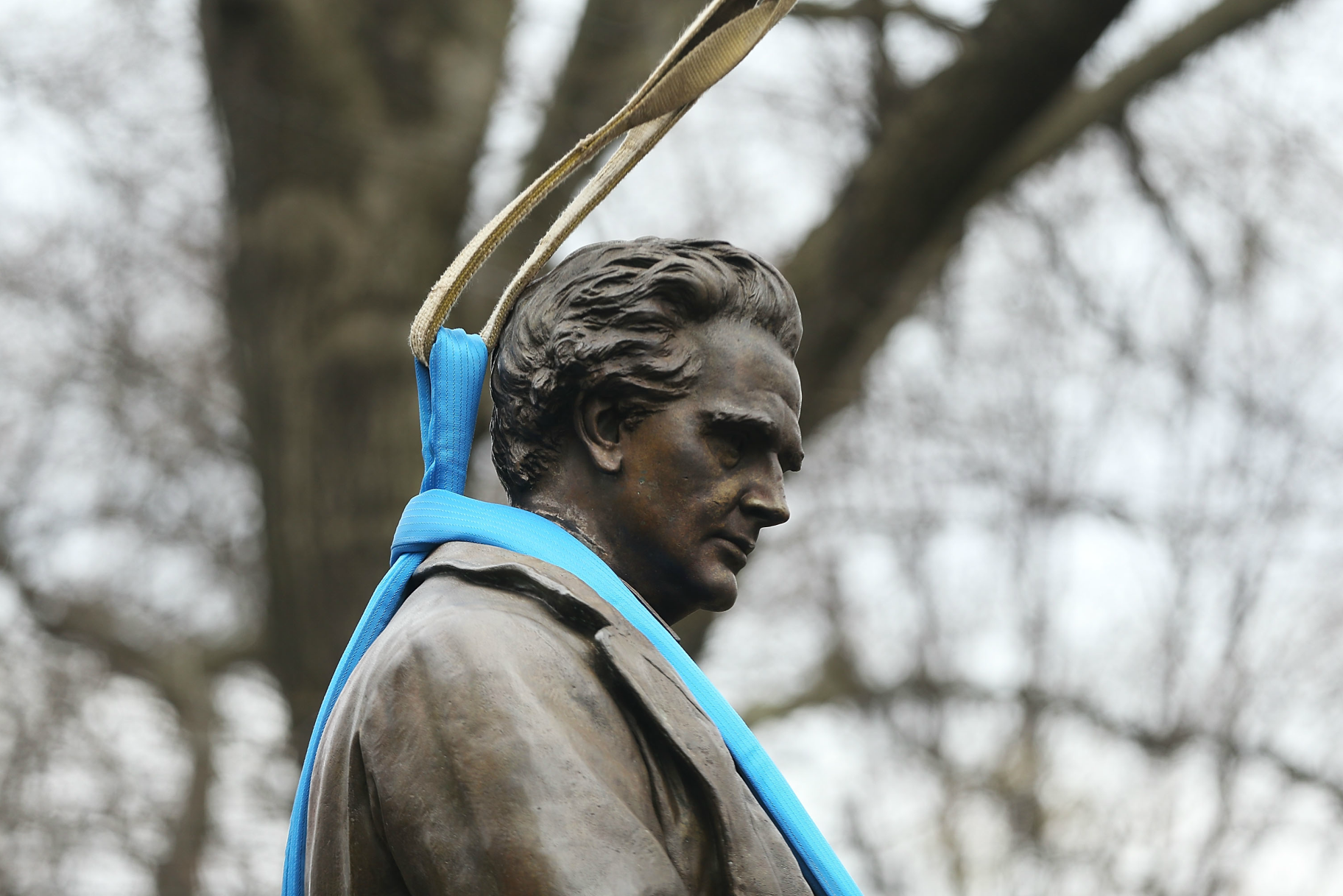Create a free profile to get unlimited access to exclusive videos, breaking news, sweepstakes, and more!
Here’s Why Feminists Are Celebrating The Dr. J. Marion Sims Statue Removal
Now Dr. J. Marion Sims’s horrific acts against black enslaved women won’t be memorialized — or forgotten any time soon.

For more than 80 years, a statue of 19th-century gynecologist Dr. J. Marion Sims stood on the corner of Fifth Avenue and 103rd Street in New York City’s East Harlem. The statue has been there since 1934, but on Monday, the city’s Public Design Commission voted unanimously to have it relocated to Sims’ burial site in Green-Wood Cemetery in Brooklyn. It was removed the very next day, prompting celebration from activists.
Why? Because, like many historical figures, Dr. Sims’ medical advancements have roots in a gory, racist past.
While Sims is known by some as the father of modern gynecology, the tools and techniques he created came at great cost. He conducted “shocking” medical experiments on enslaved black women without anesthesia, which was in the early stages of development at the time and not yet widely used, according to the History Channel. The women were treated as property and their consent, or lack thereof, was never recorded. As these enslaved women had extremely painful conditions, they became the property of Sims until their “treatments” were complete. As he later reflected in his autobiography The Story of My Life, “There was never a time that I could not, at any day, have had a subject for operation.”
In his pursuit to perfect a surgical cure for fistula, a then-incurable condition resulting from childbirth that left women incontinent, Sims performed an astonishing 30 operations on just one person — a enslaved teenager named Anarcha. Once he was satisfied with the effectiveness of his methods, and after four years of experimenting on black women, according to the History.com report, he began practicing on white women, this time with the use of anesthesia.
“These women were property,” Vanessa Northington Gamble, a physician and medical historian at George Washington University, told NPR's Hidden Brain podcast in 2016. “These women could not consent. These women also had value to the slaveholders for production and reproduction — how much work they could do in the field, how many enslaved children they could produce. And by having these fistulas, they could not continue with childbirth and also have difficulty working.” Operated on multiple times without any sort of anesthetic, these women were only treated for the slave owner’s bottomline.
Activists have long sought to have the statue of Sims in New York City removed. The acclaimed “White Man On A Pedestal” exhibit featured work by artists Doreen Garner and Kenya (Robinson) at Pioneer Works in Brooklyn, NY in late 2017. Garner not only displayed meat sculptures from a meat rack and a 3D scan of the doctor’s statue, later used in a performance, but also sought to recognize the tests subjects.
Members of the Black Youth Project 100 held a protest last year at the site of Sims’ statue, calling for it to be torn down and replaced with a monument honoring Anarcha, Betsey, and Lucy, the three enslaved women who were the subjects of Sims’ experiments and whose names we do know. Young protestors, as depicted in this screenshot from BYP100's Facebook page, wore hospital gowns stained red with paint to signify the untold suffering the slaves in Sims’ care endured in his pursuit of medical innovation.
(Screenshot: Black Youth Project 100's Facebook page)
“Memorializing of imperialist slaveholders, murderers, and torturers like J. Marion Sims is white supremacy,” Rossanna Mercedes, a member of Black Youth Project 100, told The New York Daily News.
Earlier that same month, Mayor Bill de Blasio formed a panel to perform “a 90-day review of all symbols of hate on city property,” and in January, recommended that the statue of Sims (among others) be removed. The city’s Public Design Commission voted on Monday to accept the panel’s recommendation to remove the statue, after listening to a number of testimonies from concerned individuals, The New York Post reports. They agreed to have the statue moved the very next day.
Said Signe Nielsen, the commission president: “The statue must be relocated. I am not a woman of color but am deeply moved by what I heard today.”
The statue was relocated to the cemetery on Tuesday morning, where it will remain in storage while undergoing renovations before being displayed again, this time with a marker noting Sims’ experiments, The Post reports. The granite platform Sims’ statue once occupied has been set aside for a monument that will pay tribute to Sims’ victims, no longer forgotten but uplifted by the voices of the women who came after them. More than two dozen people met in Central Park to cheer on the statue’s removal.
“I feel that my ancestors can rest,” Harlem resident Mercy Wellington told The New York Daily News, adding, “Each day I walked past that statue and I saw him up there, I felt personally disrespected. It's a historical moment for me, and it's an emotional moment. I just feel the right thing is being done.”
(Photo: A harness secures the statue of J. Marion Sims before it is driven away after being taken down from its pedestal at Central Park and East 103rd Street on April 17, 2018 in New York City. By Spencer Platt/Getty Images)



